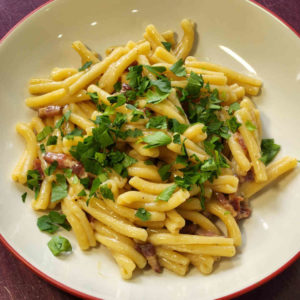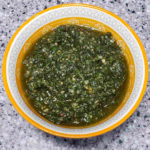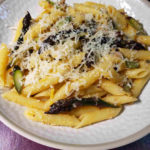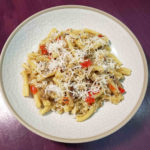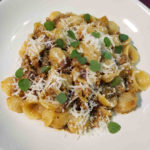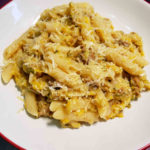I make three of the four dishes regularly. I always knew them as Italian, but I didn’t realize how specifically they were tied to the cuisine of Rome in particular. Then I saw season 1, episode 2 of Stanley Tucci’s Searching for Italy. If it’s on your streaming service, the whole series is fun to watch. Anyway, S1E2 of the series focused on Rome, and much of the episode was dedicated to these four pastas. Another fun piece to read, discussing the history of these dishes and the debates that rage on how to authentically prepare each of them is Katie Parla’s post on Serious Eats.
Anyway, here’s my write-up:
Of the countless traditional pasta dishes prepared in Italian kitchens, four are distinctly associated with Rome. Depending on how well your pantry is stocked, these may all be considered pantry pastas. While their histories are diverse, complex and debated, it’s easy to compare and contrast the dishes based on their ingredients.
Cacio e Pepe
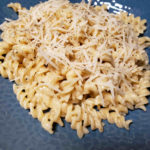
Cacio e Pepe is the simplest of the dishes. The name translates simply to cheese and pepper. Think Italian mac and cheese. Traditionally, the only ingredients are an aged, grated cheese and black pepper, which are brought together into a creamy sauce with pasta and starchy pasta water. As its name implies, Pecorino Romano is the aged grating cheese associated with Rome. Many purists would say that it is the only option for Cacio e Pepe. Others prefer to use Parmigiano Reggiano or a blend of the two cheeses. Parmigiano Reggiano is a cow’s milk cheese that is aged at least 12 months and up to 36 months. Pecorino Romano is a sheep’s milk which is aged at least five months. Both are DOP (Protected Designation of Origin) products. Less expensive Parmesans or Pecorinos are often substituted in the US. But there is something to be said about “you get what you pay for.” I really like to use Calvander as an aged grating cheese. It’s local to me. It’s a cheese in the style of aged Asiago from the Chapel Hill Creamery. And to me, that’s the more “traditional” option. The traditional cuisines of Italy used the highest quality ingredients provided by the locale. Better to use a really good, aged cheese produced locally than to use one that is shipped across the ocean!
Gricia
Gricia kicks the dish up a notch by adding cured pork. In Rome, guanciale (cured pig jowl) is traditional. Pancetta (cured pork belly) is the closest substitute. In the US, you can find both of these at specialty markets, with pancetta being more common. But the easy substitute, in the US, is bacon. Bacon is basically smoked pancetta (smoked cured pork belly). The smoke certainly adds complexity to the dish. Whether the smoke is welcome or not is up to personal taste. As with the cheese, I’m apt to use the local products. I’m perfectly OK with using bacon from pasture raised hogs that I get from my local farmers’ markets. Sometimes I can also get local guanciale, which is really nice.
Carbonara

Carbonara kicks the dish up one more notch by adding eggs. The eggs are cooked by the residual heat from the cooked pasta, forming a sauce which is even more creamy than the first two dishes. A garnish of chopped fresh parsley is also common in Carbonara. The photo shows the “Carrboro-nara” I made for Carbonara Day, April 6, 2022. All of the ingredients were sourced from the Carrboro Farmer’s Market, including local wheat bread flour for fresh pasta.
Amatriciana
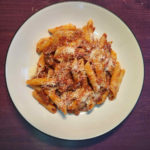
Amatriciana changes the game quite a bit. It drops Carbonara’s eggs and adds savory tomato sauce laced with spicy crushed red pepper flakes. Still, it relies on cured pork and grated aged cheese to differentiate itself from other red sauces. And, to come almost full circle. It seems that tomatoes are a totally Roman addition. Originally, in Amatrice, the town for which Amatriciana is named, did not use tomatoes. “White Amatriciana” is very similar to Gricia.
In summary:
- Cacio e Pepe: Cheese & Pepper
- Gricia: Cheese & Cured Pork
- Carbonara: Cheese & Cured Pork & Eggs
- Amatriciana: Cheese & Cured Pork & Spicy Tomato Sauce
If you are interested in how I cook the dishes, follow the links below:
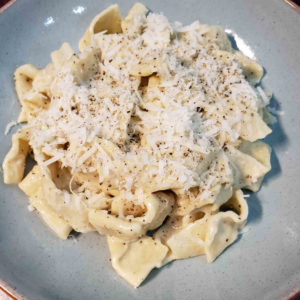
“Infallibile” Cacio e Pepe
Theoretically, Cacio e Pepe is one of the simplest pasta dishes in existence. Traditionally, the sauce is literally just three ingredients: Pecorino Romano cheese, black pepper and a splash of starchy pasta water. So, why is it so hard? Well, it can be foolproof, or as an Italian would say “Infallibile.”
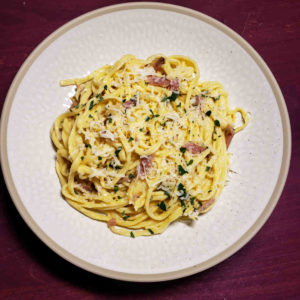
“Infallibile” Pasta Carbonara
Eggs and cheese and starchy pasta water transform into a rich and creamy sauce. Lace that with cured pork and combine with pasta, and you have one of Rome’s most famous pasta dishes. There’s a trick you should know to make the dish foolproof. Or, as Italians would say, infallibile (pronounced in·fal·lì·bi·le).
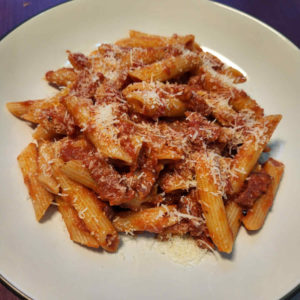
Pasta Amatriciana
Marcella Hazan titled the recipe “Amatriciana – Tomato Sauce with Pancetta and Chili Pepper.” To me, the aged cheese plays too important of a role to go uncredited. To me it is “Amatriciana – Spicy Tomato Sauce with Cured Pork and Aged Grating Cheese.”

